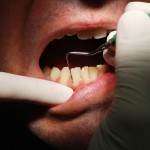
The World Health Organisation has stated that the retention, throughout life, of a functional, aesthetic, natural dentition of not less than 20 teeth and not requiring recourse to prostheses should be the treatment goal for oral health. This is consistent with the concept of the shortened dental arch (SDA) with an intact anterior region and a reduced number of occluding pairs of posterior teeth. The aim of this multicenter trial was to compare the outcomes for two different treatment options for the shortened dental arch.
Patients over 35 years of age with complete molar tooth loss in one jaw were randomized to receive either a partial removable dental prosthesis (PRDP) retained with precision attachments (n= 109) or, in the SDA group ( n= 106) no prosthetic extension of the dental arch was conducted if the posterior-most tooth was the second premolar. If the posterior-most tooth was the first premolar, a cantilever FDP for replacement of the second premolar was incorporated. In both groups, missing anterior teeth were replaced by fixed dental prostheses (FDPs). The opposing jaw had to be sufficiently restored up to the first molar in the PRDP group or the second premolar in the SDA group. Probing pocket depths ≤4 mm and generalised bleeding on probing rates ≤25% were pre-conditions to enter the prosthetic treatment phase. In the majority of cases, this condition had to be achieved by an appropriate pre-treatment. Supportive periodontal therapy (SPT) was administered depending on individual patient needs according to the protocol of the participating centres. Tooth loss was the primary outcome with plaque index (PI), probing pocket depth (PPD), vertical clinical attachment loss (CAL-V), and bleeding on probing (BOP) as secondary outcomes.
- 215 patients were recruited with 150 receiving an intervention (81 in PRDP group, 69 in SDA).
- 105 were assessed 59 in the PRDP group and 46 in the SDA group.
- 19% of the PRDP group were current smokers compared with 32% in the SDA group.
- 7% of the PRDP group and 9% of the SDA group were diabetic.
- For the distal measuring sites of the posterior-most teeth of the study jaw, significant differences were found for the PI, CAL-V, PPD and BOP. These differences were small and showed a slightly more unfavourable course in the PRDP group.
- Significant differences were also found for the study jaw as a whole for CAL-V and PPD,
| Estimated group differences over 5 years | ||
| Study Jaw | Distal sites of the posterior-most teeth | |
| Vertical clinical attachment loss (CAL-V) | 0·27 mm (95% CI 0·05; 0·48; P = 0·016) | 0·25 mm (95% CI 0·05; 0·45; P = 0·014) |
| Probing pocket depth (PPD) | 0·22 mm (95% CI 0·03; 0·41; P = 0·023) | 0·32 mm (95% CI 0·13; 0·5; P = 0·001). |
The authors concluded
that even in a well-maintained patient group statistically significant although minor detrimental effects of PRDPs on periodontal health are measurable.
Comment
We have previously highlighted the tooth loss outcomes for this study (Dental Elf 5th July 2012) and the oral health related quality of life has also been reported (Wolfart et al) and the original trial protocol is also available from www.controlled-trials.com . The authors note that although the RPDP group had the slightly more unfavourable outcomes both groups deteriorated over time. Drop out rates were slightly higher in the SDA group at 33% compared with 27% for the RPDP group, which could influence the findings.
Links
Walter MH, Marré B, Vach K, Strub J, Mundt T, Stark H, Pospiech P, Wöstmann B, Heydecke G, Kern M, Hartmann S, Luthardt R, Huppertz J, Wolfart S, Hannak W. Management of shortened dental arches and periodontal health: 5-year results of a randomised trial. J Oral Rehabil. 2014 Mar 27. doi: 10.1111/joor.12160. [Epub ahead of print] PubMed PMID: 24673467.
Walter MH, Hannak W, Kern M, Mundt T, Gernet W, Weber A, Wöstmann B, Stark H, Werner D, Hartmann S, Range U, Jahn F, Passia N, Pospiech P, Mitov G, Brückner J, Wolfart S, Busche E, Luthardt RG, Heydecke G, Marré B. The randomized shortened dental arch study: tooth loss over five years. Clin Oral Investig. 2013 Apr;17(3):877-86. doi: 10.1007/s00784-012-0761-x. Epub 2012 Jun 26. PubMed PMID: 22733244.
Wolfart S, Müller F, Gerß J, Heyedcke G, Marré B, Böning K, Wöstmann B, Kern M, Mundt T, Hannak W, Brückner J, Passia N, Jahn F, Hartmann S, Stark H, Richter EJ, Gernet W, Luthardt RG, Walter MH. The randomized shortened dental arch study: oral health-related quality of life. Clin Oral Investig. 2014 Mar;18(2):525-33. doi: 10.1007/s00784-013-0991-6. Epub 2013 May 17. PubMed PMID: 23680969.
Reissmann DR, Heydecke G, Schierz O, Marré B, Wolfart S, Strub JR, Stark H, Pospiech P, Mundt T, Hannak W, Hartmann S, Wöstmann B, Luthardt RG, Böning KW, Kern M, Walter MH. The randomized shortened dental arch study: temporomandibular disorder pain. Clin Oral Investig. 2014 Jan 23. [Epub ahead of print] PubMed PMID: 24452826.

I think its true as RPD will never be similar to the natural teeth in the way or reaction to the mastication force so there will be a irregularity in force distribution to the adjacent natural teeth which will affect both the tooth structure and supporting tissue.